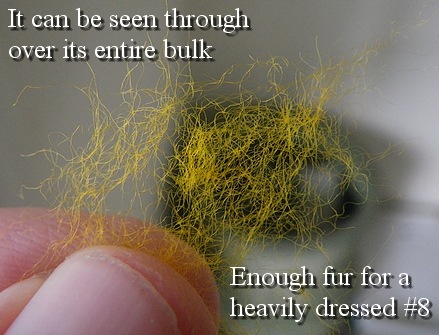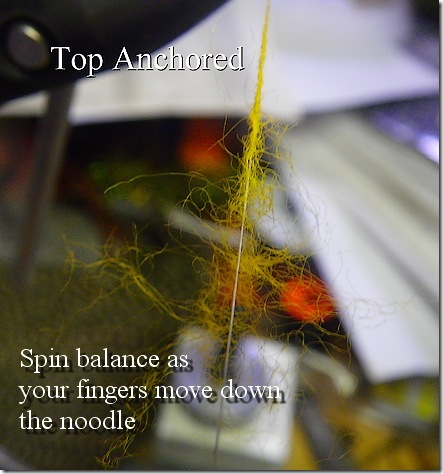I’ve always assumed that questions about the mechanics of dubbing stem from the preponderance of fly tiers that attempt to learn the craft from books, Youtube, or blog posts like this one.
Most of us contract the fly fishing bug from someone else, and while casting and simple tasks like knots are shared from one angler to the next, fly tying and its legacy of dead animals parts is an individual journey for most.
I feel the mechanical ritual described to apply fur to thread is made overly complex in most books, and seeing someone else do it is much more enlightening, especially if you can ask questions.
The neophyte usually peers from an audience at some dignitary tying at a club dinner, who’s so enraptured by a future step as to scrub a mass of fur across thread without really describing much other than what preparation is needed for the feather he’s mounting next.
It’s a step glossed over not so much out of meanness or ill temper, so much as the journey fly tyer assumes dubbing is a simplicity shared by all watching, which is not always true.
Like all things, there is a right way and many wrong ways to attempt the fur on thread nightmare.

- Dubbing isn’t applied by cutting an enormous gout of fur from the hide and dipping your fingers in pancake batter to make it stick.
- Dubbing isn’t scrubbing fingers together in both directions, it’s scrubbing fingers together in one direction only. Tiers scrubbing fingers in both directions are attempting to make the hole the hook made hurt less.
- Commercial waxed thread offers no advantage getting fur to stick to thread, that’s because the wax used by Danville and other vendors is meant to plug bobbin barrels, and is much too hard to be tacky.
- Dubbing isn’t applied, nor can it be tamed, by attacking the middle of the fur with freshly licked fingers dripping with training saliva. Training saliva is only available after drinking milk, the rest of us use mousse.
Most of your trouble starts with your dependence on packaged dubbing. Grabbing a bag of fur allow you to pull an ounce or two as easily as the merest hint of color. Mirroring your drive-thru habits, you insist on supersizing your helping – whose bulk will fight you at each and every subsequent step.

The proper amount should be transparent to the eye, and objects can be seen through the dubbing over its entire bulk.
The second portion is understanding that dubbing cannot be wrapped around thread until it is anchored to the thread at the top, with the balance of the fur then spun around the thread as the fingers move down the fur.

You can’t spin a rubber band tight, or anything tight, unless one end is “immovable” first, dubbing is no different.
It’s a devilishly simple and completely deceptive task, something that even video cannot impart completely, given that sub-steps of “hint of fur” and “anchored” are unknown to the novice, making the overall process simple yet completely foreign.

Enough for a heavily dressed size 8?!
Yikes, I need to cut down a little more.
Through your tutledge I have gotten better about using a “mist” of dubbing. I am not sure who’s voice I hear more when I tie; yours or Oliver Edwards (and what’s really strange is I’ve not heard your voice).
I’m using a norvise and tying small flies is probably not the norvise’s greatest strength, but one thing it excels at is letting you set that top anchor and then feed out the exact amount of dubbing you want. You can make it spikey or have it more compact depending on how much you spin it.
It’s great for making peacock herl ropes also. So for those reason’s (ok and the new light I got for it) I tie almost everything on it.
From Davie McPhail I think I picked up that trick of wrap, tighten the noodle, apply some more and tighten again (if needed).
Maybe I’m being snobbish, but I recently watched a video where the guy rubbed his fingers in both directions as he applied his dubbing (and make a point of saying he couldn’t dub in one direction) and I think I stopped paying attention from there on out.
The allergy-associated dubbing dispersion method is employed by some tiers, and is especially useful if the habit of overweighting the initial fur wad cannot be overcome. Your mileage may vary.
The old anchor concept……not only does it work as described here, I think it applies to most everything twisted, such as marriage…..
“Devilishly simple and completely deceptive” indeed.
Commercial waxed thread offers no advantage getting fur to stick to thread, that’s because the wax used by Danville and other vendors is meant to plug bobbin barrels, and is much too hard to be tacky.
Brilliant. Personally, I never use any wax. Even coarse guard hairs can be made to “behave” if enough pressure is applied during dubbing.
The anchoring came to me so naturally I never thought about it, but it’s true. Nice.
A video of the dubbing process is hard to make by definition: Your fingers mask most of the action.
I may dedicate an evening at the club to the subject. Never realised it could be so vexing to people.
I wish you posted this a week ago.
I think it was James Leisenring who said you should be able to tell the thread color through the dubbing, which is not a bad way at all to judge the proper noodle size. And, therefore, Leisenring was adamant about using the proper color thread so that it glowed beneath the dubbing when wet. Are we giving trout too much credit, or does it matter since we are all nuts anyway?
Great commentary. Matt G gets extra points for his exceedingly simple – yet deceptively complex commentary on marriage …
I wish you had posted this ten years ago.
I once read that you should pretend your 2″ bag of dubbing cost $50 and you won’t be supersizing each pinch anymore. So, to help make us all better tiers, you need to raise your prices on your dubbing (no more giving it away)!
Lions, tigers and bears! It’s the annual don’t over-dub missive.
Du-ah, Du-ah, Du-ah… And, nicely done!
not to get totally off subject here but when will there be more Free Range Dry Fly?